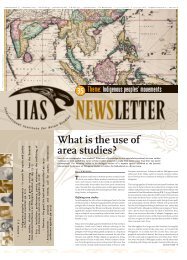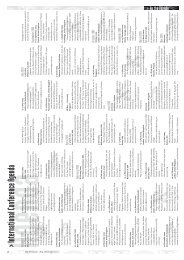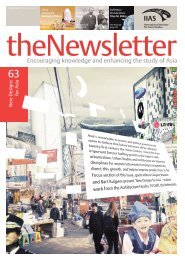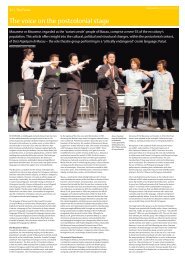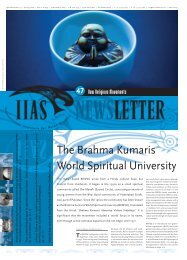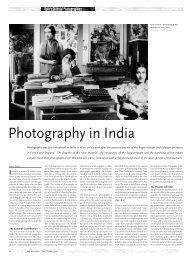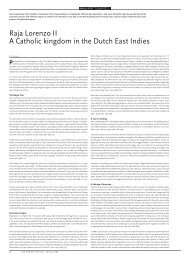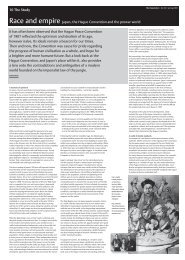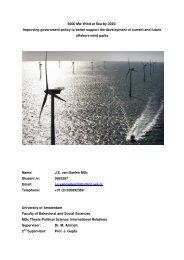Sex, love and revolution - IIAS
Sex, love and revolution - IIAS
Sex, love and revolution - IIAS
Create successful ePaper yourself
Turn your PDF publications into a flip-book with our unique Google optimized e-Paper software.
R E S E A R C H<br />
In the Netherl<strong>and</strong>s National Archives series of Dutch Sources on South Asia c. 1600-1825, Volume 2 has been published:<br />
Archival Guide to the Repositories in The Netherl<strong>and</strong>s Other than the National Archives. In contrast to Volume 1, it covers<br />
records created by Dutchmen beyond the official confines of the Dutch East India Company, such as treatises by excited<br />
scholars, drawings by inspired artists, <strong>and</strong> reports by diligent missionaries.<br />
Bogus sadhus <strong>and</strong> famous rhinos:<br />
early-modern Dutch scholars, artists, <strong>and</strong> missionaries on South Asia<br />
Lennart Bes<br />
On Sunday the 13th of May 1714, a 32 year old Hindu holy man or<br />
sadhu called An<strong>and</strong> Barti, together with eight disciples, arrived in a<br />
village near the port of Surat, on the West Coast of India. He installed himself<br />
under a big tree <strong>and</strong> started digging a hole. When curious onlookers<br />
asked him what he was up to, Barti announced that he would be buried<br />
alive in the hole in nine days time <strong>and</strong> that after three days, he would<br />
miraculously reappear on the bank of the Ganges River, hundreds of miles<br />
away. He was doing this for the general wellbeing of all who suffered <strong>and</strong><br />
to prove his holiness. Soon, the news spread to Surat <strong>and</strong> environs. During<br />
the next days, thous<strong>and</strong>s of Hindus came to see Barti under the tree<br />
<strong>and</strong> donated all kinds of gifts, including beautiful carpets <strong>and</strong> pillows for<br />
him to rest on. The sadhu blessed everyone who visited him, including a<br />
number of Muslims. Some people tried to persuade him to forget about<br />
his plans <strong>and</strong> not to put his life at risk, but Barti would not hear of it. He<br />
seemed determined to perform his miracle, subsequently making him<br />
seem even more holy to his visitors.<br />
The day prior to Barti’s burial - with more <strong>and</strong> more people gathering to<br />
witness the miracle - the Muslim authorities of Surat decided that it was<br />
getting out of h<strong>and</strong>. To stop the crowds around the sadhu from growing<br />
any further, they shut the town gates <strong>and</strong> sent a number of soldiers<br />
together with a Muslim cleric to Barti. They told him he was not allowed<br />
to carry out his plan as it was against Islamic rules, <strong>and</strong> they asked him to<br />
leave the village. To the great disappointment of the excited Hindu crowd<br />
around him, the sadhu hardly protested. He did not try to convince the<br />
Muslim authorities of his good intentions nor was he able to exert his<br />
holiness. The crowd, their expectations now shattered, grew angry <strong>and</strong><br />
started throwing stones at Barti. Hereupon, one of his disciples drew his<br />
sword to take revenge. Within moments, there was complete chaos. The<br />
sadhu tried to escape but was killed, together with a large number of his<br />
disciples. More than 50 other followers were imprisoned by the Muslim<br />
authorities, <strong>and</strong> were later circumcised <strong>and</strong> forced to convert to Islam.<br />
While the fighting was going on, a number of onlookers were robbed of<br />
their clothes <strong>and</strong> other belongings. Some other sadhus, who had been living<br />
in the village for many years, were chased away <strong>and</strong> their possessions<br />
were either burnt or sold. In the end, most of the inhabitants of Surat were<br />
very satisfied with the intervention by the Muslim authorities, especially<br />
because it turned out that Barti’s so-called grave had been fitted out with a<br />
hidden underground passage from where he could escape at night!<br />
In the wake of the Dutch East India Company:<br />
alternative sources<br />
This event is of academic importance in several fields. It tells scholars of<br />
Hinduism something about ascetic rituals performed centuries ago. Social<br />
historians may be interested in how a marginal figure could have such an<br />
impact on the people of one of the biggest ports in Asia. The event may<br />
be fascinating to political scientists studying the historical roots of South<br />
Asia’s current religious conflicts. However, Barti’s story is not described<br />
in a document held at a mosque or a temple. Neither is it found among<br />
the records of the Surat authorities. In fact, the account of the event is<br />
not kept in India at all. The story was actually reported by some Dutch<br />
traders <strong>and</strong> written down in the diary (dagregister) of the Surat establishment<br />
of the Dutch East India Company, or VOC. Unfortunately, virtually<br />
all the Dutch diaries from Surat have been lost <strong>and</strong> therefore the event is<br />
not even mentioned in the vast archives of the VOC. We only know about<br />
it because this particular section of the diary was copied for unknown<br />
reasons <strong>and</strong> somehow found its way into the private archives of the then<br />
Amsterdam-based Huydecoper family of merchants, scholars, <strong>and</strong> officials.<br />
As the family shifted its focus to the Dutch province of Utrecht in<br />
the 19th century, the document in question ended up in the holdings of<br />
the Utrecht Archives. 1<br />
As such, the report is one of the papers included in the second volume of<br />
the series of Dutch Sources on South Asia c. 1600-1825. These guidebooks<br />
aim at encouraging the use of the rich Dutch archival sources concerning<br />
the Indian subcontinent <strong>and</strong> Sri Lanka dating from the period between<br />
1600, when the Dutch first appeared in the region, <strong>and</strong> 1825, when they<br />
ab<strong>and</strong>oned their last remaining trading stations. The series’ first volume,<br />
authored by Jos Gommans, Gijs Kruijtzer, <strong>and</strong> myself, <strong>and</strong> published in<br />
2001, covers the great quantity of relevant records stored at the Dutch<br />
National Archives in The Hague. Volume 2 deals with materials scattered<br />
in other repositories in the Netherl<strong>and</strong>s: provincial, regional, <strong>and</strong> municipal<br />
archives; university libraries <strong>and</strong> other libraries; ecclesiastical organisations;<br />
museums <strong>and</strong> other public institutions; <strong>and</strong> companies, private<br />
organisations, <strong>and</strong> individuals.<br />
Whereas Volume 1 mostly covers the archives of the VOC <strong>and</strong> related institutions,<br />
largely consisting of series of consecutive papers, Volume 2 rather<br />
concerns separate documents. These were chiefly created by institutions<br />
<strong>and</strong> people whose activities took place almost literally in the wake of the<br />
VOC, such as local governments <strong>and</strong> companies, notaries, orphanages<br />
<strong>and</strong> orphan boards, churches <strong>and</strong> their missions, artists, scholars <strong>and</strong><br />
scientific societies, independent travellers, <strong>and</strong> also VOC servants <strong>and</strong><br />
their relatives in their private capacities. Therefore, these materials often<br />
contain additional information to what can be found in the official VOC<br />
records <strong>and</strong> may offer an alternative view. The remark made in 1985 by the<br />
Indian historian Ashin Das Gupta with respect to this kind of documents<br />
still holds true: ‘Researches based on the Dutch archives, so far almost<br />
exclusively confined to official papers, may ... gain important new insights<br />
from the private archives ...’ 2<br />
Focusing on archival texts, maps, drawings, paintings, <strong>and</strong> prints, the<br />
research for this archival guide has yielded many unexpected results <strong>and</strong><br />
unearthed several hitherto relatively unknown treasures. In addition to<br />
perhaps obvious records of institutions such as town governments, notaries,<br />
orphan boards, <strong>and</strong> ecclesiastical organisations, it covers a wide<br />
<strong>and</strong> colourful range of other sources dealing with numerous aspects of<br />
early-modern South Asia. These not only include trade, shipping, economics,<br />
monetary matters, <strong>and</strong> the like, but also religion, linguistics, flora<br />
<strong>and</strong> fauna, ethnology, politics, art, meteorology, warfare, etc. The story<br />
of An<strong>and</strong> Barti <strong>and</strong> his religious practices at Surat is just one example.<br />
Numerous other texts <strong>and</strong> images listed in the archival guide would be<br />
worth mentioning here, but a few more examples should suffice.<br />
Indophile Rembr<strong>and</strong>t <strong>and</strong> erratic holy rivers: pictures<br />
<strong>and</strong> maps<br />
To begin with pictures, several museums <strong>and</strong> university libraries keep<br />
beautiful oil paintings, water colours, <strong>and</strong> other drawings that concern<br />
Pen drawing of a sadhu near the village of ‘Oxkaij’ (one mile from Surat), found<br />
in the ‘Wonderen der natuur’ collection of depictions of exotic animals <strong>and</strong><br />
people as seen at the hostelry of Jan Westerhof in Amsterdam <strong>and</strong> elsewhere, c.<br />
1695-1709 (University of Amsterdam, Artis Library (University Library, Special<br />
Collections): Legkast 238 no.7<br />
both the Dutch presence in South Asia <strong>and</strong> indigenous matters. Mostly<br />
produced by Dutchmen, these pictures often seemingly not only served a<br />
practical purpose but should be considered works of art. With regard to<br />
people, there are for example drawings of Malabari pilgrims <strong>and</strong> soldiers,<br />
Ceylonese traders <strong>and</strong> beggars, Bengali widows <strong>and</strong> ascetics, Tamil musicians<br />
<strong>and</strong> dancers, <strong>and</strong> Dutch judges <strong>and</strong> tourists. Portraits include various<br />
Mughal emperors drawn by Rembr<strong>and</strong>t (who was inspired by Indian<br />
painting), Rajasthani nobles <strong>and</strong> Deccani Sultans (on Indian miniatures<br />
with Dutch captions), the Cochin-based Jew Ezekiel Rabbi, <strong>and</strong> of course a<br />
host of Dutchmen serving in the region. 3 Animals, too, have been depicted<br />
in large numbers: examples are insects <strong>and</strong> scorpions from Bengal; butterflies<br />
<strong>and</strong> snakes from Corom<strong>and</strong>el; <strong>and</strong> monkeys, birds, <strong>and</strong> crocodiles<br />
from Ceylon. 4 In a few cases, exotic South Asian animals were shipped<br />
alive to the Dutch Republic, appeared at fairs all over the country, <strong>and</strong><br />
attained star status: pictures of the Ceylonese elephant Hansken <strong>and</strong> the<br />
Assamese rhinoceros Clara can be found at various repositories. 5 Flora<br />
is also well represented, with hundreds of drawings of tropical trees <strong>and</strong><br />
plants, <strong>and</strong> even original dried specimens, partly collected for their possible<br />
medical qualities. 6<br />
Topographic materials <strong>and</strong> depictions of man-made structures abound<br />
as well <strong>and</strong> come in the shape of water colours, ink drawings, paintings<br />
on cloth, pencil sketches, <strong>and</strong> so on. Represented are for instance Bengali<br />
villages; Sinhalese, Tamil, <strong>and</strong> Oriya temples (the latter serving as useful<br />
l<strong>and</strong>marks for sea vessels); courts at Udaipur, Golkonda, <strong>and</strong> K<strong>and</strong>y<br />
receiving Dutch envoys; graves near Ahmadabad <strong>and</strong> Chidambaram; a<br />
hospital in Colombo; <strong>and</strong> Buddhist <strong>and</strong> Hindu statues. 7 There are also a<br />
large number of (bird’s-eye) views of towns, forts, <strong>and</strong> other settlements<br />
- both indigenous <strong>and</strong> Dutch - all over South Asia, ranging from Bharuch<br />
<strong>and</strong> Cambay in Gujarat to Chhapra (where the Dutch had a saltpetre factory)<br />
<strong>and</strong> Monghyr in Bihar, <strong>and</strong> from Cranganur <strong>and</strong> Cannanore on the<br />
Malabar Coast to Cossimbazar <strong>and</strong> what is probably Chittagong in Bengal.<br />
Furthermore, there are upwards of 400 maps, plans, <strong>and</strong> sea charts<br />
(both manuscript <strong>and</strong> printed), covering the entire region, be it an atoll<br />
in the Maldives (where a Dutch ship was wrecked), Kathm<strong>and</strong>u Valley (a<br />
sketch map by the Zeel<strong>and</strong> traveller Samuel van de Putte, probably the<br />
first European to visit it), Tuticorin <strong>and</strong> its fortifications on the Fishery<br />
Coast, the constantly shifting mouths of the Ganges River, or K<strong>and</strong>y <strong>and</strong><br />
its surroundings depicted circularly (probably based on a local tradition),<br />
to mention a few examples of manuscript maps. 8<br />
Sinhalese phrasebooks <strong>and</strong> unashamed Dutchmen:<br />
manuscript texts<br />
Maps <strong>and</strong> pictures make up only a minor part of the archival guide, however.<br />
Manuscript texts constitute the largest category of sources. As said,<br />
they are partly held in certain kinds of records that are available in repositories<br />
all over the Netherl<strong>and</strong>s (mostly provincial, regional, <strong>and</strong> municipal<br />
archives), such as the papers of provincial <strong>and</strong> town governments,<br />
notaries, orphan boards, <strong>and</strong> Classes of the Dutch Reformed Church. 9<br />
In particular the latter two groups maintained a regular correspondence<br />
with their representatives in India <strong>and</strong> Ceylon. Whereas these kinds of<br />
records are rather businesslike <strong>and</strong> mainly deal with the overseas activities<br />
of Dutchmen, another body of materials reflects the academic fascination<br />
with South Asia in the Dutch Republic. This seems to have flourished<br />
especially in the second half of the 18th century, when several scientific<br />
societies were founded, most notably those of Holl<strong>and</strong> <strong>and</strong> Zeel<strong>and</strong>. 10<br />
Their meetings frequently concerned South Asia as returning VOC servants<br />
held lectures, submitted treatises, <strong>and</strong> donated all kinds of objects to<br />
the societies. Thus, the societies’ archives include papers on such diverse<br />
subjects as Ceylonese Buddhism, astronomical observations made at<br />
Cochin, temperatures in Bengal, Indian embroideries, <strong>and</strong> a wild Surat<br />
cat’s eye.<br />
Already from the outset of the VOC’s presence in South Asia, however,<br />
there were Dutchmen - many of them burgomasters - with a scholarly<br />
interest in the region. In the first half of the 17 th century, Burgomaster<br />
Ernst Brinck of Harderwijk collected information on the Indies, which he<br />
arranged in small notebooks, each devoted to a specific topic. The maritime<br />
volume for example contains short references to Maldivian shells<br />
<strong>and</strong> Corom<strong>and</strong>el mermaids. 11 A few decades later, Burgomaster Hendrik<br />
d’Acquet of Delft set up a collection of naturalia from all over the<br />
world. Drawings made from these specimens, including Indian reptiles,<br />
plants, <strong>and</strong> insects, are now kept at various Dutch repositories. 12 Around<br />
1700, Gijsbert Cuper <strong>and</strong> Nicolaas Witsen, burgomasters of, respectively,<br />
2 2 I I A S N E W S L E T T E R # 4 8 S u m m e r 2 0 0 8



